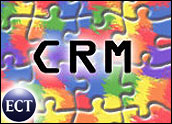
Micro marketing, one-to-one marketing, niche marketing. Whatever buzzwords are used to define it, the trend driving businesses today and tomorrow is the need to profitably serve smaller and smaller audiences.
This focus on knowing thy customer on a one-to-one basis is fueled by advances in technology, global competition and the Internet. It also has been encouraged by resistance on the part of customers to unsolicited inquiries delivered through mass marketing efforts such as telemarketing and spam e-mail, which resulted in the “Do Not Call” legislation and the proliferation of spam blockers.
Getting to know and serve customers on a one-to-one basis has CRM systems working overtime addressing the various challenges and complexities that come with the task. Consider some of the related tasks:
In the end, all of these things are accomplished and decided based on information, and the information comes from data.
Realization of Value
It is estimated that the amount of data in the world doubles every 20 months. Every transaction, every event, every blip of electricity has the potential to generate data. The Information Age promised fountains of wisdom but delivered floods of data. How valuable is each piece of data?
The best answer is that data has no value per se, but it does have potential value, and the realization of that value is determined by how it is used.
Today’s businesses are often data rich but information poor, particularly in terms of customer understanding. Turning this data into useful information is where analytical technology comes into play.
A philosopher once wrote that finding the patterns in the randomness of life is the way we create beauty and make art. A similar statement could be made about analytics, which find patterns in the randomness of data so that valuable information and insight can be discovered.
Four Categories of Analytics
There is an array of analytical products available for desktop and enterprise systems and for pros and novices alike. Generally, analytics fall into four categories.
Classification uses predictor fields to predict a categorical target field, such as which groups of people will respond to an offer.
Segmentation divides subjects, objects or variables into a number of relatively homogeneous groups (e.g., segmenting consumers into usage pattern groups). Use of statistical analysis to classify and segment can help to increase the likelihood that the right offer is made to the right person at the right time.
For example, a user can request that data be analyzed to display a spreadsheet showing all of a company’s widgets sold in Wyoming in the month of August, compare revenue figures with those for the same products in October, and then see a comparison of other product sales in Wyoming in the same time period.
To facilitate this kind of analysis, OLAP data is stored in a multidimensional database, which considers each data attribute (such as product, geographic sales region, and time period) as a separate “dimension.” OLAP enables marketers to quickly review history and trends to take advantage of emerging opportunities, and take corrective action on developing problems.
Data mining provides a clear picture of what is going to happen in time to change it. For example, it can show who the best customers might be, which customers are likely to defect, or, if the right data is gathered, which carry the risk of adverse reaction to marketing offers.
Text mining extracts terms and phrases, and then automatically classifies the terms into related groups, such as products, organizations or people, using the meaning and context of the text. Text mining can be used to analyze call agent notes and to provide real-time feedback, such as scripts that can be used to pitch cross-sell and up-sell offers.
With the combination of text mining and data mining, call center scripts can be changed instantly to reflect how the caller matches the pattern of previous calls. As the customer speaks or writes, the agent is immediately able to analyze their current and future needs.
In this new era of one-to-one marketing, analytics will add more science to the art of marketing. With analytics, businesses will gain a deeper customer understanding that will enable them to market more efficiently and effectively. The result will be what businesses have always wanted: higher profitability and the ability to keep customers loyal and happy — one customer at a time.
Colin Shearer is vice president of customer analytics for SPSS Inc.







































It is so important for companies that have a large customer base to do what they can to "get to know them" on an individual basis. But with so many customer communications entering the data warehouse everyday, it can become difficult to drill down to an individual and address their specific needs.
Unstructured communications (like emails, the "other" text areas on surveys, online feedback forms) are often overlooked as a source of information because they are so difficult to extract information from. But there are now some viable software options on the market that are really getting a grip on this type of data, allowing companies to analyze large quantities of unstructured text in real-time and returning information on customer satisfation, technical issues, up-sell opportunities, etc.
Unlike typical structured data such as the 1-10 responses on surveys, unstructured textual communications really give you the meat of what a customer likes and dislikes about your product or service. For example, when you ask a person "how are you feeling on a scale of 1 to 10" and they respond with a 1, you then have to be able to come up with the correct follow-up question to find out why they aren’t feeling well. "Are you sick?" No. "Did you have a bad day at work?" No. And so on and so forth. Had you simply asked them "How are you feeling" and given them a open text box they would have told you in detail that they aren’t feeling well because of A, B and C reasons. Now, if you could automatically analyze their response you would have some seriously valuable information on your hands that would allow you to respond to the customer on a personalized level. That’s pretty powerful and, in my opinion, the next era of customer intelligence.
There are a few companies offering software for this type of analysis. They include: Island Data Corp. http://www.islanddata.com and Attensity http://www.attensity.com.
Totally agree that communications with your customer is key. With that said, all communications should be relevant to the consumer and should enrich your knowledge of the customer rather than communicating for communications sake. A good site that talks about this is http://www.crmtrends.com/crm.html – they also have a pretty good analytics section as well.